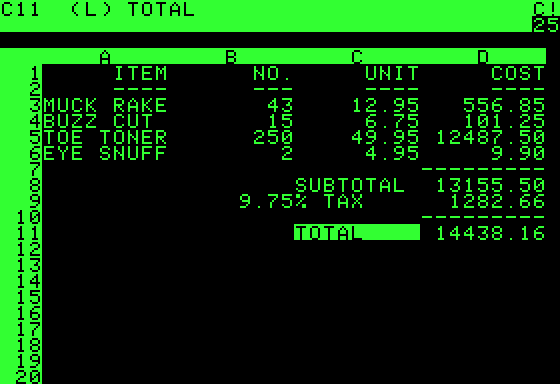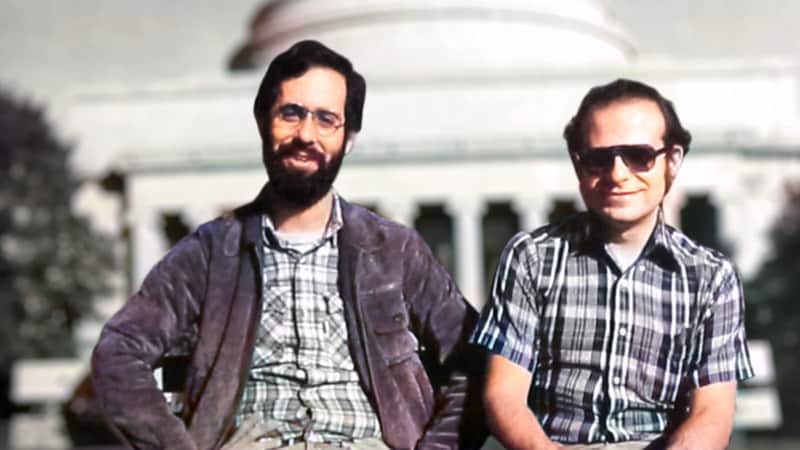
Key Points and Facts about VisiCalc:
- VisiCalc (short for “visible calculator”) was the first spreadsheet computer program for personal computers, launched by VisiCorp in 1979 for the Apple II.
- VisiCalc is famously known as “The killer app” for the Apple II.
- It sold over 700,000 copies in six years and up to one million copies during its existence.
- In formulas, VisiCalc uses the A1 notation.
- VisiCalc of Dan Bricklin and Bob Frankston uses Apple II, Apple SOS, CP/M, Atari 8-bit family, Commodore PET, TRSDOS, Sony SMC-70, DOS, and HP series 80 operating system.
What is VisiCalc: Explained
VisiCalc was the first spreadsheet program released in 1979 for the Apple II computer. It was easy to use and allowed for data sorting and storing in tabular rows and columns. VisiCalc was created to address and replace the manual spreadsheet management method. Changing a single value meant modifying the entire spreadsheet because changes made to one cell were automatically applied to all connected cells with VisiCalc. This program was one of the most critical factors in making personal computers more appealing to everyday customers and companies instead of hobbyists and techies.

For many users, the application best demonstrated the value of personal computers for small businesses, reducing a 20-hour-per-week bookkeeping task to a few minutes of data entry in certain circumstances. A simple spreadsheet with columns for employee names and addresses, Social Security numbers, hourly pay, hours worked, tax deductions, and net income, for example, might hold payroll data. For each employee, a formula might be applied to cells in the last column to compute compensation as a function of cells in the three preceding columns. The spreadsheet would display the net pay and the formula upon request. All net pay cells could be recalculated if tax withholding rates were modified.
Quick Facts
- Creator (person)
- Dan Bricklin, Bob Frankston
- Release Date
- 17/10/1979
- Original price
- under $100
- Units Sold
- 1000000
- Operating System
- Apple II, Apple SOS, CP/M, Atari 8-bit family, Commodore PET, TRSDOS, Sony SMC-70, DOS, HP series 80
- Developed By (company)
- Software Arts, published by VisiCorp
It’s widely regarded as the first “killer app,” a piece of software so crucial that you’d buy a computer only to use it. Steve Jobs eventually recognized that VisiCalc “powered the Apple II to the success it achieved,” according to Mr. Bricklin’s website. As a result, many accountants and business owners divided their professional experience into two periods within a few years: before and after the computerized spreadsheet was introduced.
VisiCalc: Release History
In the spring of 1978, a Harvard Business School student, Dan Bricklin, came up with the idea for an interactive visible calculator, the program (called VisiCalc), which would later be called the First Killer App of the Computer Era. Bricklin certainly was not the inventor of the electronic spreadsheet. The first known ideas for such a program were from 1961 when professor Richard Mattessich pioneered the development of computerized spreadsheets for use in business accounting. Then in 1969 Rene Pardo and Remy Landau co-invented “LANPAR” LANguage for Programming Arrays at Random, an electronic spreadsheet-type application, which was used for budgeting at Bell Canada, AT&T, Bell operating companies, and General Motors. Mattessich, Pardo, and Landau’s work and that of other developers of spreadsheets on mainframe computers probably had no influence on Bricklin however. Thus, a history of the modern era of microcomputer-based electronic spreadsheets should begin with VisiCalc.
Daniel Singer Bricklin was born on 16 July 1951, in Philadelphia, USA, where he attended Akiba Hebrew Academy during his high school years. Then he received a B.S. in electrical engineering/computer science from MIT (Massachusetts Institute of Technology), before going for an MBA from Harvard University in 1977.
Once sitting in his room, as he remembered …I would daydream. “Imagine if my calculator had a ball in its back, like a mouse…” (I had seen a mouse previously, I think in a demonstration at a conference by Doug Engelbart, and maybe the Alto). And “…imagine if I had a heads-up display, like in a fighter plane, where I could see the virtual image hanging in the air in front of me. I could just move my mouse/keyboard calculator around on the table, punch in a few numbers, circle them to get a sum, do some calculations, and answer ‘10% will be fine!'” (10% was always the answer in those days when we couldn’t do very complicated calculations…)
Later in the summer of 1978, between the first and second year of the MBA program, while riding a bike along a path on Martha’s Vineyard, he decided that he wanted to pursue this idea and create a real product to sell after he graduated.
So in the spring of 1978, Bricklin tried prototyping the product’s display screen in Basic on a video terminal connected to the Business School’s timesharing system. His hope for using a mouse was replaced in the first personal computer prototype in the early fall of 1978 by the game paddle of the Apple ][. (This was a dial one could turn to move game objects back and forth). One could move the cursor left or right, and then push the “fire” button, and then turning the paddle would move the cursor up and down. The R-C circuit or whatever in the Apple ][ was too sluggish and my pointing too imprecise to accurately position the cursor that way, so I switched to the two arrow keys of the Apple ][ keyboard (it only had 2) and used the space bar instead of the button to switch from horizontal movement to vertical.
The first PC prototype of VisiCalc was created over a weekend on an Apple ][ (using Apple Integer Basic), borrowed for the purpose from a friend, Dan Fylstra, later his publisher. It did not scroll, yet, but it had the columns and rows and some arithmetic.
Then Bricklin decided to recruit a more experienced programmer, to do a real, assembler version of the program (first for the MOS Technology 6502 microprocessor used in the Apple ][). Thus he called his MIT colleague Bob Frankston, to build production code (faster speed, better arithmetic, scrolling, etc.). Frankston not only managed to code the program in assembler (using an assembler, that ran on a minicomputer equipped with the Multics operating system) but also expanded the program and packed the code into a mere 20k of machine memory, making it both powerful and practical enough to be run on a microcomputer. Actually, the size of the program was the biggest problem for Frankston because Apple II had a limited memory, 16 KB of RAM on the low-end Apple II. No matter how hard Frankston tried, however, he could not fit VisiCalc in the 16, that’s why VisiCalc would only be available for the much more expensive 32 KB Apple II.
Bricklin and Frankston formed Software Arts Corporation in January 1979. In May 1979, the firm Personal Software of Dan Fylstra (later renamed VisiCorp) began marketing VisiCalc with a teaser ad in Byte Magazine (see the nearby image). Initially, Bricklin conceived several names for the program, between them Calcu-ledger and Calcu-paper, but the name “VisiCalc” is an abbreviated form of the phrase “visible calculator” that was chosen by Dan Fylstra.
VisiCalc was one of the key products that helped bring the microcomputer from the hobbyist’s desk into the office. Before the release of this groundbreaking software, microcomputers were thought of as toys; VisiCalc changed that.
VisiCalc went on sale in November of 1979 and became immediately a big hit. It retailed for US$100 and sold so well that many dealers started bundling the Apple II with VisiCalc. The success of VisiCalc was one of the main reasons Apple turned into a successful company, selling tens of thousands of the pricey 32 KB Apple IIs to businesses that wanted them only for the spreadsheet.
VisiCalc: End of Development
VisiCalc’s price had climbed from $100 to $250 by 1982. Several competitors entered the market, including SuperCalc and Multiplan, each of which offered new capabilities and rectified flaws in VisiCalc, but they could not challenge the software’s market domination.
Lotus 1-2-3, written by former Personal Software-VisiCorp employee Mitch Kapor, who had also written VisiTrend and VisiPlot, was released in 1983 and marked a more significant shift. Unlike VisiCalc for the PC, 1-2-3 was designed to take full advantage of the PC’s more excellent memory, screen, and performance. However, it was created to be as similar to VisiCalc as possible, including the menu layout so that VisiCalc users could transfer to 1-2-3. However, due to the striking features of Lotus, sales of VisiCalc practically evaporated.
By 1984, sales of VisiCalc had “rapidly declined,” according to InfoWorld, and it was “the first successful software product to have gone through a complete life cycle, from conception in 1978 to introduction in 1979 to peak success in 1982 to decline in 1983 to a probable death according to industry insiders in 1984.” According to the magazine, the business was hesitant to improve the program, only delivering an Advanced Version of VisiCalc for the Apple II in 1983 and announcing one for the IBM PC in 1984. Its sales plummeted so swiftly that it was forced to declare bankruptcy by 1985.
Lotus Development purchased the company in 1985 and promptly discontinued the sale of VisiCalc and the remainder of the company’s products.

The image featured at the top of this post is ©User: Gortu, Public domain, via Wikimedia Commons.
